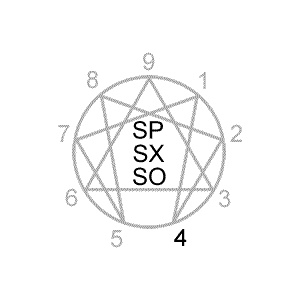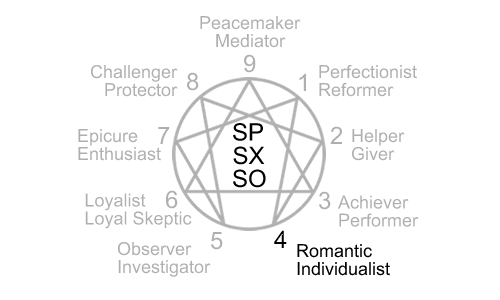Enneagram Type 4 Instinctual Subtypes: SP 4, SX 4, SO 4
The core focus of Enneagram type 4

You are unique, and if that is not fulfilled, then something has been lost.
- Martha Graham
Early in life we develop an initial belief about ourselves and a compensation for that self-belief.
-
Type 4 Initial Self-Belief: “I am lacking as I am.”
Type 4 Compensation: "I must find and cultivate what's authentic and uniquely special about myself to stand out from the ordinary."
Over time this gets generalized beyond the self into a core focus that also shapes how we perceive and interact with the world at large.
-
Type 4 Core Focus: Significance comes from cultivating what is unique and emotionally authentic in myself. This requires that I discover and stay true to what has emotional meaning for me and find ways to express that through my own identity and in the world around me.
Personality characteristics that might arise from the type 4 core focus include:
- Cultivates and maintains moods they identify with
- Holds in disdain what's common in pursuit of what's special
- Stirs up or intensifies emotional states to feel more alive
- Feels more emotionally sensitive and deeper than others
- Takes things personally even when not intended that way
- Notices what's missing or lacking in self compared to others
- Creates idealized self from what they emotionally resonate with
- Looks for ways to express their inner emotional world
- Wants to deal with internal emotions before moving forward
Enneagram type 4 instinctual subtypes

The Enneagram instincts are self-preservation (sp), sexual (sx), and social (so). The sexual (sx) instinct is also called the intimate or one-to-one instinct.
The instincts are traditionally used to define three instinctual subtypes or variations of a basic type (e.g., SP 4, SX 4, and SO 4). One of these three subtypes is called the counter-type because it can look different from the basic type.
Below are brief descriptions of the three type 4 instinctual subtypes.
SP 4 - Dauntless, Tenacity (counter-type): stoically endures pain and suffering rather than playing the victim; willingness to jump into new territory in pursuit of personal passion; can be self-punishing, demanding of self in order to forge oneself toward an ideal.
SX 4 - Competition, Hate: “more shameless than shameful” in their demand for what they want; competes with others to overcome feelings of internal deficiency; angry envy toward others who have what they don’t or are what they’re not.
SO 4 - Shame, Honor: attracts support by expressing their suffering to others, takes on the victim role; self-defeating focus on sense of inferiority when comparing self to others; feels guilty for wishing, desiring, shameful feelings about self in comparison to others.
While an individual may be identified with type 4 in general, that same individual may be more specifically identified with one of the three instinctual subtypes as well.
A more recent approach to using the instincts is instinctual variant stacking which can be used independent of Enneagram type.
What Enneagram authors say about type 4 instinctual subtypes

Below are Enneagram 4 subtype description samplings from some popular or well-known Enneagram authors. Click on the sources after the descriptions to further explore these interpretations.
-
In the average range, Self-Preservation Fours tend to be the most practical and materialistic kind of Fours.1
In the average range, Sexual Fours most exemplify the romanticism, intensity, and longing for a rescuer that characterize this type.1
In the average range, Social Fours, more so than the other Fours, see themselves as unlike others and being totally unique.1
-
Dauntlessness (Recklessness) Regarding Personal Survival: Recreate the possibility of loss through reckless actions. The excitement of playing the edge of disaster.2
Competition in One-to-One Relationships: Fours often compete because of a need to be worthy in the eyes of a desirable mate; “wanting the respect of the best people.”2
Shame in Social Relationships: Shame at not measuring up to group standards. It’s that all eyes are upon you when you walk into a room; they can see that you’re wrong inside.2
-
Self-Preservation Fours: Can be reckless, court disaster or just flirt lightly with loss. Take chances to stir up emotional intensity, play out melodrama or to get attention.3
Intimate Fours: Tend to be highly competitive in close relationships but also more generally. Want to be the most important person in mate’s life.3
Social Fours: Prone to shame because they compare themselves with the “normal” world around them. May romanticize their defects but feel bad about themselves anyway.3
-
Type 4 Instinctual Subtypes by Beatrice Chestnut
Self-Preservation Four: "Tenacity"
Is stoic in the face of their inner pain and they don’t share it with others as much as the other two Fours. Instead of dwelling in envy, they act out their envy by working hard to get what others have and they lack.4Sexual Four: "Competition"
Makes others suffer as an unconsious way of trying to rid themselves of painful feelings of deficiency. They express "an envy that wants," unconsciously turning their pain at inner lack into feelings of anger about not gettng what they need from others.4Social Four: "Shame"
Suffers more, feels more shame, and is more sensitive than the other two Fours. Envy fuels a focus on shame and suffering as they employ a strategy of seducing others into meeting their needs through an intensification of pain and suffering.4
Sources
1Book: The Wisdom of the Enneagram; Website: The Enneagram Institute
2Book: The Enneagram; Website: The Narrative Enneagram
4Book: The Complete Enneagram; Website: Chestnut Paes Enneagram Academy
To learn more about the instincts click on a link below.
Enneagram Tests to Help Determine Instinct

There are two approaches to using the Enneagram personality instincts.
The instinctual subtypes describe three variations of each of the Enneagram types: a self-preservation (sp), sexual (sx), and social (so) subtype.
Instinctual variant stacking can be used with or without reference to Enneagram type by determining an individual's preferential order for the the three instincts (i.e., sp/sx, sx/sp, sp/so, so/sp, sx/so, or so/sx).
-
Instinctual Subtype Test
This test compares the three instinctual subtypes for a given type.
Use when you know your type and want to find your instinctual subtype for that type. -
Instinctual Variant Stacking Test
This test ranks the three instincts to determine your preferential order of the instincts.
Use when you want to know your instinctual variant stacking independent of type.
To learn more about Enneagram personality type 4 click here.
Click here for the Complete Guide to the Enneagram.
This free guide explains- the nine Enneagram personality types
- the many type variations within type
- where the types came from (origins and history)
- how the types use the Enneagram symbol
Click here for Enneagram tests.
These free tests help you find your- primary type
- candidate types
- preferred wing
- intinctual subtype
- instinctual variant stacking
- center types (gut, heart, and head)
- tri-center with wings